#monster hunter biology
Explore tagged Tumblr posts
Text
Divine Serpents





Admittedly not some of my best work cause some of these are quite old and I might have misinterpreted some instructions from the big man UHC himself, but hey, I'm finally back to work after 4 months of just gaming and not taking much commissions
youtube
Speaking of, feel free to drop by my Ko-Fi to commission me if you wanna see some of your ideas brought to some life (my prices have gone up due to some.... expensive habits of mine but I can still assure quality works for the price you pay)
as for my thoughts on Narwabushi themselves, i'll be open about this and say: They really suffered from the curse of covid writing bringing them down as antagonistic monsters and as designs (and resonance being rather poorly implemented as a plotpoint) but their actual fights and the music with said fights is just

peak boss music even
up next a 4 piece combo of rocks, gases and bones, Basarios/Gravios and Urag/Radobaan
#thunder serpent narwa#wind serpent ibushi#nergigante#monster hunter art#source filmmaker#sfm art#monster hunter#monster hunter biology#monster hunter rise#speculative biology#speculative ecology#amatsu#Unnatural History Channel#UHC#Narwa the Allmother#Youtube
21 notes
·
View notes
Text

Dyuragaua skull made with parave anatomy
i may not have the model of dyuragaua yet but atleast i got some nice game images to get a good idea to draw his head!
I absolutely love Dyuragaua hes one of my favorite frontier monsters his design is silly yet awesome looking and i enjoy his fight! Hes better than Mi-Ru (even tho i said before i like him out of irony)
hopefully you will like this skull! :>
#monster hunter#skulls#speculative anatomy#speculative biology#monster hunter biology#dyuragaua#flying wyvern
28 notes
·
View notes
Text

youtube
#monster hunter#mh#rathalos#rivalry#mh posting#monster hunter monster#monster hunter biology#video essay#monster hunter espinas#monster hunter lore#capcom#monster hunter wilds#tumblr recommendations#recommend#recommendation#youtube#youtube content#youtube recommendations#youtube video#video recommendation#youtube link#video link
1 note
·
View note
Text
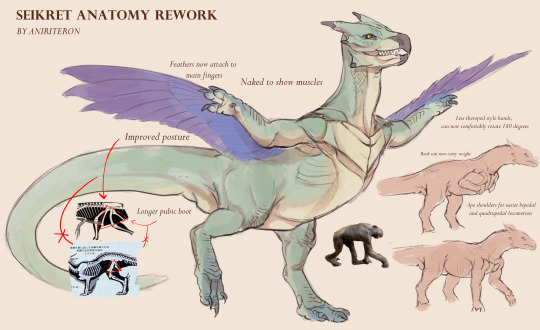
not with the intent to change anything or 1 up capcom. this is my attempt to make sense to the anatomy. free to use, this is really for future notes.
idk how they fly and im not gonna put the special shoulder to wrist wing tendon idk the name of there rn
these types of arm can still provide your seikret with 25mph (40kph) of running speed, while the current estimate to the non modified seikret is 28mph (44Kph), thankfully not a significant loss.
#speculative fantasy#2025#spec evo#speculative anatomy#speculative biology#speculative worldbuilding#spec bio#seikret#theropod#dinosaur#mhwilds#monster hunter wilds#monhun#anatomy#tutorial
159 notes
·
View notes
Text


i’m gonna lose my mind i’m so in love with him . i can’t fucking do this. Erik
#cydraws#monster hunter#monster hunter wilds#mhwilds#erik#erik monster hunter#i’m actively having a breakdown rn so these are not my best work#HES SO CUTE I LOVE HIM#i’m the erik guy i hold this title nobody else can. My Character#fun fact i drew these on my notes for an old science project :3 i felt he’d enjoy living with my model of phyllorhiza punctata#he’s in his natural habitat (biology work)
64 notes
·
View notes
Text

Playing around with the designs of Gaismagorm and Diablos and trying to make them look more "streamlined" to suit their lifestyles as burrowers given that their builds kinda look poorly suited for moving through loose ground.
Gaismagorm is more mole-like, its former wings being large scoop-like excavating implements while both its front and hind legs have been reduced to paddles meant mostly just for shoving loose soil aside. Its claw-like tail is used to anchor itself when moving backwards, its body is more compact, and its eyes have completely atrophied, using its "horns" which are now more like starnose mole tendrils to feel and sense its way around.
Diablos meanwhile is more penguin-inspired, able to slide through loose sand with ease. Its tusks and horns are all angled forward to pierce through the sand with minimal effort, its frill contours with the rest of its body, and its legs and wings are short, broad and flat to push through the ground, with the wings still retaining highly-vascularized webbed membranes to act as heat sinks to help cool down in the hot desert.
#speculative biology#fantasy biology#creature design#monster hunter#gaismagorm#diablos#elder dragon#wyvern
35 notes
·
View notes
Text
The Wyvern with a stone Face: Gravios

#monster hunter#gravios#monster hunter art#wyverns#armor wyvern#speculative biology#speculative ecology#speculative evolution#speculative zoology#traditional art#traditional sketch#basarios#wyvern
28 notes
·
View notes
Text
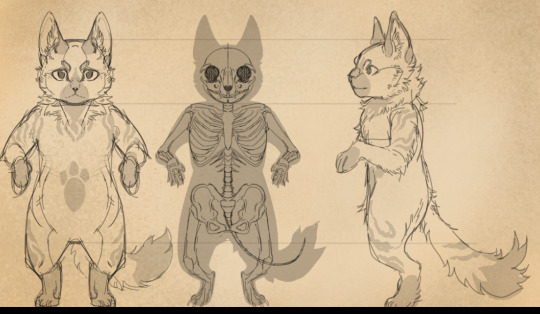
a bit of lynian biology headcanons! drawing them is weird so im figuring out their anatomy
#digital art#fantasy#art#oc#monster hunter stories 2#mhs2#monster hunter#felyne#lynian#palico#spec bio#speculative biology#cat#mh#monhun#mhw
82 notes
·
View notes
Note
What do you think is Nu Udra? How could it relate to Nakarkos or Yama?
Is it a vert-

So going off the 8 arms and generally floppy body this is likely an octopus. Specifically within Octopodoidea and likely closely related to Enteroctopodidae (yellow and giant octopus), Octopodidae (common, blue ringed, and mimic octopodes), and Megaleledonidae.


Granted, Nu is very unique anatomically, likely due to being a terrestrial cephalopod.
The big one is that it’s in contact with fresh water. Fresh water is a massive hurdle for cephalopods because of osmotic stress, basically they have no mechanism to keep fresh water from sucking the salt out of their cells. I’d imagine though that Nu gets around this by having thicker skin (it seems to have a texture like that of a toad) and mucus membranes.
Its gills might have transitioned into lungs.
The beak is further forward on the body and not in the middle of all the arms, likely to make it easier to eat things since without the support of water it’s probably harder to position itself over top of food.
It seems to have gotten rid of almost all suckers, maybe for friction reasons??? But I don’t know any logical reason for the loss aside from the devs probably didn’t want to program and animate them all. What few suckers remain have been turned into massive hooks, which isn’t unusual for a cephalopod. Squids have some nasty talons.
Apparently Nu Udra has bad eyesight and it doesn’t even have pupils, and has sensory organs on the tips of its arms. This gives the tips of the arms a sort of cupped shape like a hectocotylus, which would make it pretty hard to tell which individuals are males. Granted Capcom has a pretty firm no-no rule on giving the monsters private parts, the most they’ve done is arse-holes and rajang’s glowing pubes.
Its relation to Nakarkos is pretty much like that of any other octopus and cuttlefish. And Nark is explicitly a cuttlefish. It doesn’t drop elder dragon blood when killed and gives you cuttlebones. In a recent wilds dev interview they said they wanted to go squid-ier with nark like Nu Udra but couldn’t due to technical limitations.
Yama…


Is a British man.
#monster hunter#speculative evolution#speculative biology#ask#questions#monsterhunter#monhun#monster hunter biology#nu udra#carlos98sworld-blog1
116 notes
·
View notes
Text
Eater of Elders




well, UHC's giving me a bit of a break for Art atm, not to say I'm on art break again, but it would be nice to see people's ideas come to fruition, if you have such ideas, you can commission me on ko-fi
#nergigante#monster hunter#monster hunter biology#speculative biology#source filmmaker#monster hunter world#rajang#elder dragon#fanged beast#monster hunter art#speculative ecology
33 notes
·
View notes
Text

Shantien skull using Actinistian skulls for reference
this is possibly the toughest skull i've done so far but this is also my first time drawing an elder dragon skull so its no surprise it would be this difficult and especially Shantien's terribly modeled cranium! (it fucking has no nostrils)
i also used @iamthekaijuking's many elder dragon skulls as reference since i like his Actinistian elder theory its pretty neat!
overall im quite happy with it i also quite like shantien's design i think he looks neat and i even designed a character after him!
#monster hunter#art#shantien#skull#speculative anatomy#speculative biology#monster hunter biology#elder dragon
28 notes
·
View notes
Text

youtube
#monster hunter#monster hunter lore#capcom#monster hunter rise#monster hunter world#mh world#mh rise#lore#mh posting#lore video#compilation#compilation post#creatures#creature#fantasy creature#fantasy#monsters#monster hunter iceborne#mh iceborne#monster hunter biology#fantasy creatures#video compilation#tumblr recommendations#recommend#recommendation#youtube#youtube content#youtube recommendations#youtube video#video recommendation
0 notes
Text

Semi realistic Rathalos and Rathian.
21 notes
·
View notes
Text
Namielle Marine Biology Post
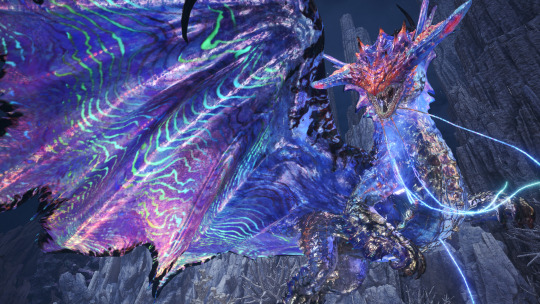
Hello fellow hunters!!!
I’ve been wanting to rant about this for a little while so I’m doing it to all of you :D!
This post is gonna be about the elder dragon Namielle, and why she’s just an absolute masterpiece of a design for a sea related dragon.
As a zoology student who’s hoping to work in marine biology, Namielle immediately stuck out to me. I’m always a fan of deep sea based designs, but namielle was different because of how *real* all of her little adaptations felt. It felt to me like the team that designed her didn’t just slap colors and lights on her wherever, but took the time to understand why deep sea animals have the adaptations that they do, and to think about how that would apply to this creature. This isn’t a post that’s entirely about in-universe ecology of namielle, as monster-huntologist has already done a brilliant post on that, but instead it’ll be about various design elements on namielle, the creatures I think they’re inspired by, and how those adaptations work. This is going to be an incredibly long post, but I hope it’s interesting to y’all and that you maybe learn something new from it! So let’s get into it!
A quick disclaimer that I make no claim to be an expert in marine biology. I’m just passionate about it, and I’m not a professional yet. Plus, the nature of science is that we never really know everything, especially not for certain, so this information might become out of date or just be flat out wrong.
I’m going off of the assumption that Namielle is able to live both underwater and on land. We fight her in the coral highlands, but she has so many sea-specific adaptations that it’s hard for me to believe she’s purely a land dwelling creature. Perhaps there’s access to the sea somewhere in the lower coral highlands (assuming the highlands is bigger than the area we can access in game) or near the vale, or there’s underground water. For living on land, I’m going to assume that either she’s able to use the same system that allows her to contain water for attacks for breathing on land, that she has lungs as well as gills, or that elder dragons can just live wherever the hell they want.
I’m also applying the logic of “fuck it, it’s an elder dragon” to how namielle can exist in these environments that have wildly different pressures, since the coral highlands is, well, a highlands, and the deep sea is very high pressure. It’s an elder dragon, don’t worry about how it can just ignore pressure I guess. Anyways, on to things I *can* somewhat explain.
First, we’ll start with her body coloration. The dorsal (top/back) side of her body is black, and the ventral (bottom/belly) side of her body is paler. This is a type of camouflage called *counter-shading*. It’s exhibited by a ton of sea creatures, like orcas and various porpoises/dolphins, sharks, manta rays, and many more! the way it functions is simple but incredibly effective. Let’s say you were swimming in the ocean, and a Namielle was directly below you. As you look down, you only see the dorsal (back) side of her body, so it’s a black shape against the dark water below you. If you were directly below her, you’d see her ventral side, so a pale blue against the light water above you. Here’s a couple of drawings I did to help explain this (I did these in like 5 minutes, I’m fully aware that they’re absolute garbage lol)
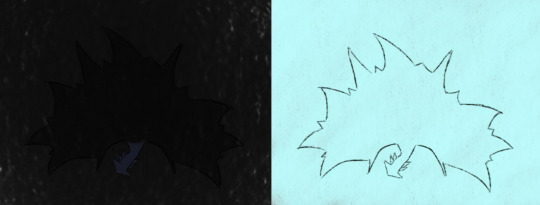
Similarly, all of the lights on Namielle are on the underside of her body. This allows her to use another form of camouflage called counter-illumination, which species like squids and various fish exhibit as well. When seen from below, the lights would help merge her shape with the light scattering through the water above the prey. This would be especially effective when the namielle is in an enraged state, when the entire underside of the wings light up in ripple-like patterns. This picture from Wikipedia shows the general idea of this method.
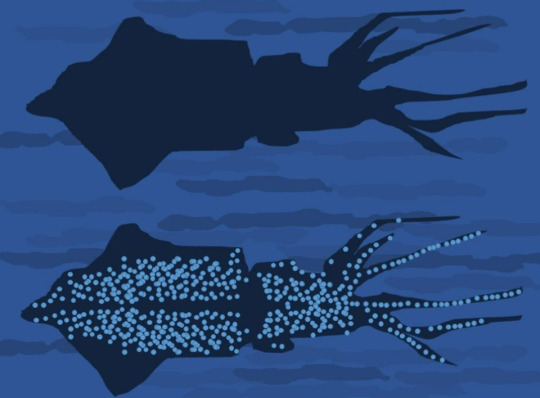
Let’s talk a little bit more about those lights. Bioluminescence is quite common in deep sea animals, and for a wide variety of speculated reasons. The lights on Namielle closely resemble that of a comb jelly, which is a fascinating group of ctenophores (so not a true jellyfish, just related to them!) Though in the case of some comb jellies, they aren’t actually bioluminescent, but rather the comb rows within their body are incredibly reflective and scatter light like a prism as they move in the water. Since namielle has this effect on land, and we can see it happen in the dark, I’m pretty sure she is actually bioluminescent, but I could be wrong. The cells that would create this effect are called photocytes, and in ctenophores they often use calcium to activate specific proteins called photoproteins in order to generate light.
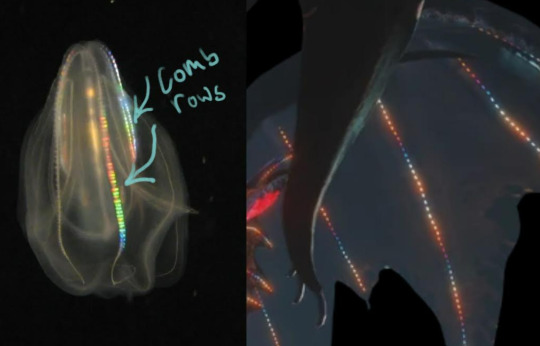
There’s a whole bunch of reasons why namielle could have these lights. They provide some counter illumination as mentioned earlier, but that’s almost certainly not the only reason. Namielle could use them for communication with other members of the species, since having specific patterns of lights would make finding each other easier in the complete and utter blackness of the deep ocean. Namielles could also use these lights like an anglerfish to lure in prey. Judging by their size, I’m going to assume that the namielle primarily eats fish or other similarly sized prey. Hell, they probably also can hunt on land, as food in the deep sea can get pretty scarce sometimes.
Let’s talk about namielle’s beautiful face for a bit. The shape of her head is quite flat, with the points on the sides of her head reminding me somewhat of a hammerhead shark. Her eyes are quite small, so I think that underwater she hunts primarily with other senses. Since she’s also able to live on land, I’ll assume that she does have good eyesight in both land and water, but other senses serve better in the darkest areas. It’s possible that she has organs similar to a shark’s ampullae of lorenzini, which are pores located on the snout of the shark that allow them to sense electromagnetic fields. Her long whiskers may also be used to hunt prey, similar to the vibrissae of a seal. In seals, their whiskers are so sensitive that they can catch prey just fine with little to no eyesight, it’s a really interesting adaptation that I definitely recommend reading more about if you’re curious. Back to namielle, she has a wide mouth with very interesting teeth. She seems to have two rows of teeth, so she might be constantly losing and regrowing teeth like a shark. The needle-like shape suggests that they primarily are used for ripping and shredding meat. An interesting detail I noticed is that her teeth are sort of transparent, which is a trait real deep sea creatures have. Take the dragonfish for example, its teeth are very similar to namielle’s. While it’s not been studied quite as much as I’d hoped, biologists have determined that the structure of the teeth is what makes it transparent. Their teeth lack structures called dentin tubules that are what normally give teeth their color, and also contain nanocrystal structures that most animals don’t have in their teeth. It’s theorized that their teeth are transparent for camouflage reasons, since bright white teeth would stand out against a black colored animal, potentially giving them away. Also credit to u/vers_first on Reddit for this absolutely hilarious screenshot that perfectly shows off her lovely teeth.

Another notable feature is the red coloration. Color is difficult to see underwater, since the wavelengths get absorbed by the water. Red is the first color to disappear, becoming dull grey at around 15-20 feet below the surface depending on water conditions. The amount of red coloration on namielle’s body, like on the wings and head, mean that when submerged in water namielle can become nearly invisible, only the blue/white and black on her body visible enough to be used for camouflage, as well as the lights. This image from the official artworks is a pretty good representation of what a namielle would look like while glowing and below ~20 feet of water. As you can see, it basically just disappears except for the lights.
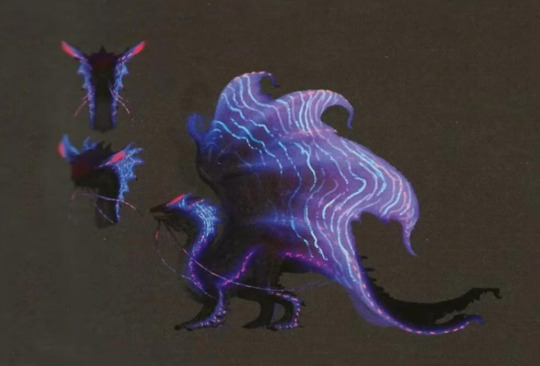
Namielle is able to store water within its body, and likely mix it with saliva or mucus to produce the slime that they shoot when threatened or hunting. This likely isn’t something that namielle can do indefinitely, it’d probably need to drink lots of water to maintain this on land, and in the sea it’d get its water supply from the food that it eats. In fact, while I was reviewing my footage of namielle, I noticed that I seem to have caught her drinking/absorbing water from the blue sponge corals in the highlands!
youtube
Though, it’s likely that it doesn’t use the slime when in the sea, since goo projectiles don’t work super well underwater. It’s likely that she uses another specialization to hunt when under water: electricity!
Those who have dived into the world of monster hunter ecology likely know about the theory that thunder element is very risky for monsters to use since our nervous systems run on electricity and generally don’t react well to more of it, and that most monsters that do use electricity either have adaptations to protect themselves (like khezu using their tail to ground their bodies, or astalos being adapted to just continue to function with high amounts of their piezoelectricity shocking themselves) or by not actually generating electricity within their bodies (like zinogre’s symbiotic relationship with thunderbugs, or tobi-kadachi generating static forces in its fur)
This isn’t the case with namielle, as being an elder dragon means it can basically do whatever it wants. Namielle canonically has a special organ within its body that creates electric charge. I’m going to assume that this functions similarly to an electric eel. Those guys have special disc shaped cells called electroplaques that produce charges, which are released when a specific neurotransmitter is produced. More specifically, the nerve terminals on the organ create transient paths for the electricity that connect the inside and the outside of the cells, turning each individual cell into a miniature battery. These batteries all activate each other in a cascading effect, producing a shock in just nanoseconds. But you may be wondering why these eels (and thus namielle) don’t just fry their own nervous system with all this electricity. Truth is, we aren’t entirely sure how they don’t, but here’s what we do know. The electric cells are structured inside the body in such a way as to create a parallel circuit that is separated from important organs such as the heart and the brain, which significantly reduces the danger. They also don’t shock randomly, only when they need to. They can also shift their bodies to prevent just nailing their heart with the electric current. However, they likely feel something when they discharge a shock, since they have electroreceptors and contract their muscles when they shock something. Taking a look at the namielle armor, it has 15 thunder resistance. To me, this says that namielle has adapted to have some kind of insulation within their body that lessens the shock to their own systems when they use these electrical abilities.
Let’s talk about the wings now.
Namielle’s wings are made up of a membrane connected to its tail. The wings are incredibly flexible, so it probably has thin cartilage “finger bones” within the wings, or they have flat sheets of cartilaginous tissue within the wings like a manta ray. It could also be similar to the webbing of a vampire squid, where it has a tentacle structure that’s connected by a membranous web. It actually tucks its wings around itself in a very vampire squid-ish shape, which I thought was pretty neat. The edges of the wings have tentacle like structures, but I’m unsure how prehensile these are.
Namielle seems to have a skeletal structure similar to that of a seahorse, where it is made up of overlapping plates of bony materials beneath the skin rather than the shape that we usually think of as bones being. The seahorse in this image is very dead and has been dried out, which allows us to see the structure of the boney plates while still having skin over them. You can see the resemblance to the seahorse especially on the face and the legs, notice the ridged texture. These bones are very flexible and are able to slide and bend around and against each other, giving the namielle structure and armor. This armor is especially effective against crushing, since the force of a blow is distributed throughout the skeleton. This however is less effective on spots where the bones are smaller and thinner/more spread out, such as the legs, head, and underbelly, hence why those are the main weak spots in addition to breakable wings and a severable tail.
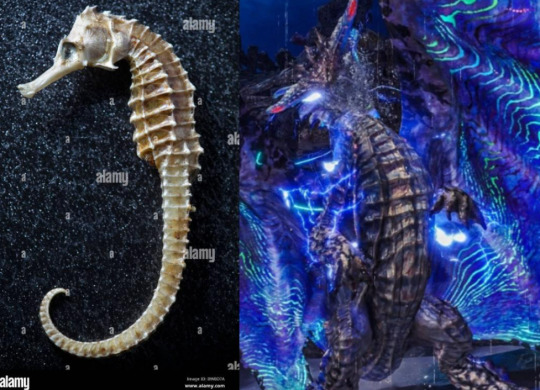
Speaking of the tail, the way it’s connected to the wings suggests to me that it uses is to balance itself in the water, as well as perhaps for steering. This has the advantage of working in both air and water, since flying and swimming are surprisingly similar.
The sounds that namielle makes are very interesting, as they resemble the sounds made by marine mammals like seals, dolphins, and orcas. For neat examples, listen to the spaceship-like sound of an adult weddell seal, as well as various orca calls. Namielle is incredibly intelligent (basically sapient since it’s an elder dragon) and these sounds are likely used for communication.
Overall, namielle is a brilliant example of a fantasy creature that’s designed with a basis in reality, since after all reality is often stranger than fiction.
That’s all I have for now, but if I think of any more details I’ll come back and edit this post. If you have anything to correct or add, please let me know, I’d love to talk about this more!
#monster hunter#monster hunter world#mhworld#mhw iceborne#monster hunter world iceborne#speculative biology#namielle#Youtube
12 notes
·
View notes
Text

The Gunslinger spider
Name pending
Species: Temnoceran
My first ever monster hunter monster oc! inspired by boleadora spiders, this large monster keeps a herd of common prey monsters (such as aptonoth) within its territory in order to attract the flying wyverns it preys upon (and as livestock in case of emergency); extremely territorial about its herd, will not just attack its preferred prey but also anything that threatens them.
The boulders it stacks in its back and webbed bag act both as natural armor and camouflage as well as its ammo, as it attaches the rocks to threads of silk in order to hurl them at its prey both to knock it down and to entangle and pull at it.
Around its mouth there are pores that produce threads of silk which help detect vibrations in the air, and also can be combined with the sticky substance produced by its fangs (gets more viscuous when in contact with air) to quickly weave threads in the middle of a fight. There are accounts of older and more experienced individuals using smaller, ignitable stones with its front limbs to directly engage opponents in close combat, causing burns and concussions from the blasts (an action very reminiscent of one of Qurupeco's abilities, perhaps these older individuals have engaged in fights with them? to predate them or to take advantage of their call?)
#monster hunter#monster hunter oc#monster hunter monster oc#monster oc#temnoceran#spider#mebi's art#digital art#krita#rkgk#spec evo#speculative biology#speculative ecology#this is also inspired by cowboys if it isnt obvious lol
146 notes
·
View notes
Text
isekai where an evolutionary biologist gets transported to the Monster Hunter world
#im not as biology brained as i was before but i still see mh designs and lore and go insane thinkgin about it#monster hunter#muffin.txt
6 notes
·
View notes